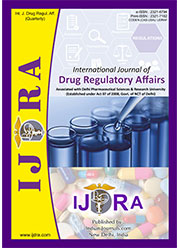Haemovigilance: New approach for safe Blood transfusion
Abstract
Haemovigilance is an urgent need of the country to identify and prevent occurrence or recurrence of transfusion related adverse reactions, thereby to increase the safety and quality of blood transfusion and blood products administration. Haemovigilance is an organised scheme of monitoring, identifying, reporting, investigating and analysing adverse events and reactions pertinent to transfusion and manufacturing blood products. Thus the information collected will facilitate corrective and preventive actions to minimise the potential risks associated with blood collection, processing and transfusion to patients. Indian Pharmacopoeia Commission has started a Haemovigilance Program of India (HvPI) in 2012 under its Pharmacovigilance Program of India (PvPI) in collaboration with National Institute of Biologicals (NIB), Noida, Uttar Pradesh, under Ministry of Health and Family welfare, Government of India with a primary objective to track adverse reactions/events and incidences associated with blood transfusion and blood product administration. The main objective of this article is to brief (s) about the system which monitors each and every step of transfusion reaction.
Downloads
References
2. IPC-NIB Guidance Document for reporting serious adverse reactions in blood transfusion service. National Institute of Biological, Ministry of Health and Family Welfare, Government of India. 2012; 30(1):1-31
3. Bisht A, Singh S, Marwaha N. Haemovigilance program-India, Asian J Transfus Sci. [Internet]. 2013 Jun [cited 2019 Aug 14]; 7(1):73–74. Available from: https://www.ncbi.nlm.nih.gov/pmc/articles/PMC3613669/
4. Jain A & Ravneet. Haemovigilance and blood safety. Asian J Transfus Sci. 2012; 6(2): 137-138.
5. A guide to establishing a national haemovigilance system [Internet]. Geneva: WHO; 2016 [cited 2019 Aug 17]. Available from: https://apps.who.int/iris/bitstream/handle/10665/250233/9789241549844-eng.pdf
6. World Health Organization. Global Consultation on Haemovigilance 20-22 November 2012, Dubai, United Arab Emirates. [Internet]. Geneva: WHO; 2012 [cited 2019 Aug 18]. Available from: http://www.who.int/bloodsafety/haemovigilance/haemovigilance-report.pdf
7. Mukherjee S and Maiti R. Haemovigilance: A Current Update in Indian Perspective. Journal of Clinical and Diagnostic Research: Jcdr. [Internet]. 2019 Nov 01 [cited 2019 Aug 19]; 10(11):EE05-EE09. Available from: http://europepmc.org/articles/PMC5198342
8. Mukherjee S and Maiti R. Haemovigilance: A Current Update in Indian Perspective. Journal of Clinical and Diagnostic Research: Jcdr. [Internet]. 2019 Nov 01 [cited 2019 Sept 12]; 10(11):EE05-EE09. Available from: https://www.researchgate.net/publication/310618561_Haemovigilance_A_Current_Update_in_Indian_Perspective
9. Bassi R, Aggarwal S, Bhardwaj K, & Thakur K K. Patterns of Adverse Transfusion Reactions in a Tertiary Care Centre of North India: A Step Towards Haemovigilance. Indian Journal of Haematology and Blood Transfusion. 2016; 33(2): 248-53.doi:10.1007/s12288-016-0684-9.
10. National Institute of Biologicals; Ministry of Health & Family Welfare, Govt. of India (National coordinating centre). Transfusion Reaction Reporting Form (TRRF) for Blood & Blood Components & Plasma Products. [Internet]. India: National Institute of Biologicals; 2018 [cited 2019 Aug 19]. Available from: http://nib.gov.in/haephp/haemovigilance_login.php.
11. Bisht A, Marwaha N et.al. Haemovigilance Programme of India: Analysis of transfusion reactions. Asian Journal of Transfusion Sciences. 2018 Jan-Jun; 12(1): 1-7.

This work is licensed under a Creative Commons Attribution-NonCommercial 4.0 International License.
The International Journal of Drug Regulatory affairs require a formal written transfer of copyright from the author(s) for each article published. We therefore ask you to complete and return this form, retaining a copy for your records. Your cooperation is essential and appreciated. Any delay will result in a delay in publication.
I/we have read and agree with the terms and conditions stated Page 2 of this agreement and I/we hereby confirm the transfer of all copyrights in and relating to the above-named manuscript, in all forms and media, now or hereafter known, to the International Journal of Drug Regulatory affairs, effective from the date stated below. I/we acknowledge that the IJDRA is relying on this agreement in publishing the above-named manuscript. However, this agreement will be null and void if the manuscript is not published in the IJDRA.
Download link for COPYRIGHT FORM







